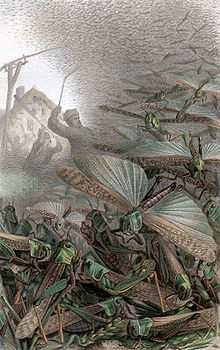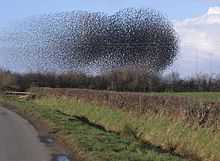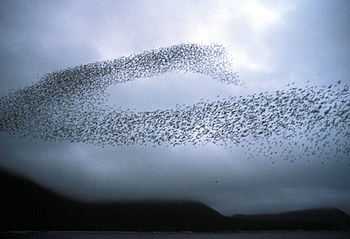Self-propelled particles

Self-propelled particles (SPP), also referred to as self-driven particles or as the Vicsek model, is a concept used to model swarm behaviour.[1][2] The concept was introduced in 1995 by Tamas Vicsek et al.[3] as a special case of the Boids model introduced in 1986 by Reynolds.[4] A swarm is modelled in SPP by a collection of particles that move with a constant speed but respond to a random perturbation by adopting (at each time increment) the average direction of motion of the other particles in their local neighbourhood.[5]
SPP models predict that swarming animals share certain properties at the group level, regardless of the type of animals in the swarm.[6] Swarming systems give rise to emergent behaviours which occur at many different scales, some of which are turning out to be both universal and robust. It has become a challenge in theoretical physics to find minimal statistical models that capture these behaviours.[7][8][9]
Overview
The SPP model is based on a collection of points or particles, each functioning individually as an autonomous agent, and each following the same simple rules which govern their behaviour. The particles move in a plane with constant speed but in different directions. The direction of each particle is updated using a "nearest neighbor rule", a local rule which replaces the direction of each particle with the average of the particle's own direction plus the directions of its immediate neighbours.[10]
|
– needs Java |
Simulations demonstrate that a suitable "nearest neighbour rule" eventually results in all the particles swarming together, or moving in the same direction. This emerges, even though there is no centralised coordination, and even though the neighbours for each particle constantly change over time (see the interactive simulation in the box on the right).[3]
Although more realistic swarming models have been explored,[12] the SPP model remains important because of its simplicity and the strength and the variety of its emergent phenomena.[10] The SPP model is an agent-based model based on a Lagrangian viewpoint, which follows individual particles rather than working with the density of the swarm.[9] It is a discrete-time switched linear system which is stable, even though no common quadratic Lyapunov function exists.[10] It is an analogue of the Ising model in ferromagnetism, where temperature corresponds to the randomness of particle orientation and spin clusters correspond to particle clusters.[3]
Examples

|
When the density of locusts reaches a critical point, they march steadily together without direction reversals. |
Marching locusts
Young desert locusts are solitary and wingless nymphs. If food is short they can gather together and start occupying neighbouring areas, recruiting more locusts. Eventually they can become a marching army extending over many kilometres.[13] This can be the prelude to the development of the vast flying adult locust swarms which devastate vegetation on a continental scale.[14]
One of the key predictions of the SPP model is that as the population density of a group increases, an abrupt transition occurs from individuals moving in relatively disordered and independent ways within the group to the group moving as a highly aligned whole.[15] Thus, in the case of young desert locusts, a trigger point should occur which turns disorganised and dispersed locusts into a coordinated marching army. When the critical population density is reached, the insects should start marching together in a stable way and in the same direction.
In 2006, a group of researchers examined how this model held up in the laboratory. Locusts were placed in a circular arena, and their movements were tracked with computer software. At low densities, below 18 locusts per square metre, the locusts mill about in a disordered way. At intermediate densities, they start falling into line and marching together, punctuated by abrupt but coordinated changes in direction. However, when densities reached a critical value at about 74 locusts/m2, the locusts ceased making rapid and spontaneous changes in direction, and instead marched steadily in the same direction for the full eight hours of the experiment (see video on the left). This confirmed the behaviour predicted by the SPP models.[6]
In the field, according to the Food and Agriculture Organization of the United Nations, the average density of marching bands is 50 locusts/m2 (50 million locusts/km2), with a typical range from 20 to 120 locusts/m2.[14]:29 The research findings discussed above demonstrate the dynamic instability that is present at the lower locust densities typical in the field, where marching groups randomly switch direction without any external perturbation. Understanding this phenomenon, together with the switch to fully coordinated marching at higher densities, is essential if the swarming of desert locusts is to be controlled.[6]
Bird landings

Swarming animals, such as ants, bees, fish and birds, are often observed suddenly switching from one state to another. For example, birds abruptly switch from a flying state to a landing state. Or fish switch from schooling in one direction to schooling in another direction. Such state switches can occur with astonishing speed and synchronicity, as though all the members in the group made a unanimous decision at the same moment. Phenomena like these have long puzzled researchers.[17]
In 2010, Bhattacharya and Vicsek used an SPP model to analyse what is happening here. As a paradigm, they considered how flying birds arrive at a collective decision to make a sudden and synchronised change to land. The birds, such as the starlings in the image on the right, have no decision-making leader, yet the flock know exactly how to land in a unified way. The need for the group to land overrides deviating intentions by individual birds. The particle model found that the collective shift to landing depends on perturbations that apply to the individual birds, such as where the birds are in the flock.[16] It is behaviour that can be compared with the way that sand avalanches, if it is piled up, before the point at which symmetric and carefully placed grains would avalanche, because the fluctuations become increasingly non-linear.[18]
"Our main motivation was to better understand something which is puzzling and out there in nature, especially in cases involving the stopping or starting of a collective behavioural pattern in a group of people or animals ... We propose a simple model for a system whose members have the tendency to follow the others both in space and in their state of mind concerning a decision about stopping an activity. This is a very general model, which can be applied to similar situations."[16] The model could also be applied to a swarm of unmanned drones, to initiating a desired motion in a crowd of people, or to interpreting group patterns when stock market shares are bought or sold.[19]
Other examples
SPP models have been applied in many other areas, such as schooling fish,[20] robotic swarms,[21] molecular motors,[22] the development of human stampedes[23] and the evolution of human trails in urban green spaces.[24] SPP in Stokes flow, such as Janus particles, are often modeled by the squirmer model,.[25]
References
- ↑ Degond, P.; Motsch, S. (2007). "Continuum limit of self-driven particles with orientation interaction". SIAM Journal on Applied Math. arXiv:0710.0293. Bibcode:2007arXiv0710.0293D.
- ↑ Setekera, R. (2009). Numerical simulation of herding and flocking models (Masters thesis). Supervisor A. Klar. Technische Universiteit Eindhoven.
- ↑ 3.0 3.1 3.2 Vicsek, T.; Czirok, A.; Ben-Jacob, E.; Cohen, I.; Shochet, O. (1995). "Novel type of phase transition in a system of self-driven particles". Physical Review Letters 75 (6): 1226–1229. arXiv:cond-mat/0611743. Bibcode:1995PhRvL..75.1226V. doi:10.1103/PhysRevLett.75.1226. PMID 10060237.
- ↑ Reynolds, C.W. (1987). "Flocks, herds and schools: A distributed behavioral model". Computer Graphics 21 (4): 25–34. doi:10.1145/37401.37406. ISBN 0897912276. CiteSeerX: 10
.1 ..1 .103 .7187 - ↑ Czirók, A.; Vicsek, T. (2006). "Collective behavior of interacting self-propelled particles". Physica A 281: 17–29. arXiv:cond-mat/0611742. Bibcode:2000PhyA..281...17C. doi:10.1016/S0378-4371(00)00013-3.
- ↑ 6.0 6.1 6.2 Buhl, J.; Sumpter, D. J. T.; Couzin, D.; Hale, J. J.; Despland, E.; Miller, E. R.; Simpson, S. J. (2006). "From disorder to order in marching locusts". Science 312 (5778): 1402–1406. Bibcode:2006Sci...312.1402B. doi:10.1126/science.1125142. PMID 16741126.
- ↑ Toner, J.; Tu, Y.; Ramaswamy, S. (2005). "Hydrodynamics and phases of flocks". Annals of Physics 318 (170): 170. Bibcode:2005AnPhy.318..170T. doi:10.1016/j.aop.2005.04.011.
- ↑ Bertin, E.; Droz, M.; Grégoire, G. (2009). "Hydrodynamic equations for self-propelled particles: microscopic derivation and stability analysis". Journal of Physics A 42 (44): 445001. arXiv:0907.4688. Bibcode:2009JPhA...42R5001B. doi:10.1088/1751-8113/42/44/445001.
- ↑ 9.0 9.1 Li, Y. X.; Lukeman, R.; Edelstein-Keshet, L. (2007). "Minimal mechanisms for school formation in self-propelled particles". Physica D: Nonlinear Phenomena 237 (5): 699–720. Bibcode:2008PhyD..237..699L. doi:10.1016/j.physd.2007.10.009.
- ↑ 10.0 10.1 10.2 Jadbabaie, A.; Lin, J.; Morse, A.S. (2003). "Coordination of groups of mobile autonomous agents using nearest neighbor rules". IEEE Transactions on Automatic Control 48 (6): 988–1001. doi:10.1109/TAC.2003.812781. CiteSeerX: 10
.1 – convergence proofs for the SPP model..1 .128 .5326 - ↑ "Self driven particle model". Interactive simulations. University of Colorado. 2005. Retrieved 10 April 2011.
- ↑ Helbing, D. (2001). "Traffic and related self-driven many-particle systems". Reviews of Modern Physics 73 (4): 1067–1141. arXiv:cond-mat/0012229. Bibcode:2001RvMP...73.1067H. doi:10.1103/RevModPhys.73.1067.
- ↑ Uvarov, B. P. (1977). Behaviour, ecology, biogeography, population dynamics. Grasshopper and locust: a handbook of general acridology II. Cambridge University Press.
- ↑ 14.0 14.1 Symmons, P.M.; Cressman, K. (2001). "Desert locust guidelines: Biology and behaviour". Rome: FAO.
- ↑ Huepe, A.; Aldana, M. (2004). "Intermittency and clustering in a system of self-driven particles". Physical Review Letters 92 (16): 168701 [4 pages]. Bibcode:2004PhRvL..92p8701H. doi:10.1103/PhysRevLett.92.168701.
- ↑ 16.0 16.1 16.2 Bhattacharya, K.; Vicsek, T. (2010). "Collective decision making in cohesive flocks". arXiv:1007.4453. Bibcode:2010NJPh...12i3019B. doi:10.1088/1367-2630/12/9/093019.
- ↑ "Self-Propelled Particle System Improves Understanding Of Behavioral Patterns" (Press release). Medical News Today. 18 Sep 2010.
- ↑ Somfai, E.; Czirok, A.; Vicsek, T. (1994). "Power-law distribution of landslides in an experiment on the erosion of a granular pile". Journal of Physics A: Mathematical and General 27 (20): L757–L763. Bibcode:1994JPhA...27L.757S. doi:10.1088/0305-4470/27/20/001.
- ↑ "Bird flock decision-making revealed". Himalayan Times. 2010-09-14.
- ↑ Gautrais, J.; Jost, C.; Theraulaz, G. (2008). "Key behavioural factors in a self-organised fish school model". 45: 415–428.
- ↑ Sugawara, K.; Sano, M.; Watanabe, T. (2009). "Nature of the order-disorder transition in the Vicsek model for the collective motion of self-propelled particles". Physical Review E 80 (5): 050103 [1–4]. Bibcode:2009PhRvE..80e0103B. doi:10.1103/PhysRevE.80.050103.
- ↑ Chowdhury, D. (2006). "Collective effects in intra-cellular molecular motor transport: coordination, cooperation and competition". Physica A 372 (1): 84–95. arXiv:physics/0605053. Bibcode:2006PhyA..372...84C. doi:10.1016/j.physa.2006.05.005.
- ↑ Helbing, D.; Farkas, I.; Vicsek, T. (2000). "Simulating dynamical features of escape panic". Nature 407 (6803): 487–490. arXiv:cond-mat/0009448. Bibcode:2000Natur.407..487H. doi:10.1038/35035023. PMID 11028994.
- ↑ Helbing, D.; Keltsch, J.; Molnar, P. (1997). "Modelling the evolution of human trail systems". Nature 388 (6637): 47–50. arXiv:cond-mat/9805158. Bibcode:1997Natur.388...47H. doi:10.1038/40353. PMID 9214501.
- ↑ Bickel, Thomas; Majee, Arghya; Würger, Alois (2013). "Flow pattern in the vicinity of self-propelling hot Janus particles". Physical Review E 88 (1). doi:10.1103/PhysRevE.88.012301. ISSN 1539-3755.
Further references
- Bertin, E.; Droz, M.; Grégoire, G. (2009). "Hydrodynamic equations for self-propelled particles: microscopic derivation and stability analysis". Journal of Physics A 42 (44): 445001. arXiv:0907.4688. Bibcode:2009JPhA...42R5001B. doi:10.1088/1751-8113/42/44/445001.
- Czirók, A.; Stanley, H. E.; Vicsek, T. (1997). "Spontaneously ordered motion of self-propelled particles". Journal of Physics A 30 (5): 1375–1385. arXiv:cond-mat/0611741. Bibcode:1997JPhA...30.1375C. doi:10.1088/0305-4470/30/5/009.
- Czirók, A.; Barabási, A. L.; Vicsek, T. (1999). "Collective motion of self-propelled particles: Kinetic phase transition in one dimension". Physical Review Letters 82 (1): 209–212. arXiv:cond-mat/9712154. Bibcode:1999PhRvL..82..209C. doi:10.1103/PhysRevLett.82.209.
- Czirók, A.; Vicsek, T. (2001). "Flocking: collective motion of self-propelled particles". In Vicsek, T. Fluctuations and scaling in biology. Oxford University Press. pp. 177–209. ISBN 978-0-19-850790-1.
- D'Orsogna, M. R.; Chuang, Y. L.; Bertozzi, A. L.; Chayes, L. S. (2006). "Self-propelled particles with soft-core interactions: patterns, stability, and collapse". Physical Review Letters 96 (10): 104302. Bibcode:2006PhRvL..96j4302D. doi:10.1103/PhysRevLett.96.104302.
- Levine, H.; Rappel, W. J.; Cohen, I. (2001). "Self-organization in systems of self-propelled particles". Physical Review E 63: 017101. arXiv:cond-mat/0006477. Bibcode:2001PhRvE..63a7101L. doi:10.1103/PhysRevE.63.017101.
- Mehandia, V.; Nott, P.R. (2008). "The collective dynamics of self-propelled particles". Journal of Fluid Mechanics 595: 239–264. arXiv:0707.1436. Bibcode:2008JFM...595..239M. doi:10.1017/S0022112007009184.
- Helbing, D. (2001). "The wonderful world of active many-particle systems". Advances in Solid State Physics 41. pp. 357–368. doi:10.1007/3-540-44946-9_29.
- Simha, R. A.; Ramaswamy, S. (2006). "Hydrodynamic fluctuations and instabilities in ordered suspensions of self-propelled particles". Physical Review Letters 89 (5): 058101. arXiv:cond-mat/0108301. Bibcode:2002PhRvL..89e8101A. doi:10.1103/PhysRevLett.89.058101.
- Sumpter, D. J. T. (2010). "Chapter 5: Moving together". Collective Animal Behavior. Princeton University Press. ISBN 978-0-691-12963-1.
- Vicsek, T. (2010). "Statistical physics: Closing in on evaders". Nature 466 (7302): 43–44. Bibcode:2010Natur.466...43V. doi:10.1038/466043a.
- Yates, Christian A. (2007). On the dynamics and evolution of self-propelled particle models (MSc thesis). Somerville College, University of Oxford.
- Yates, Christian A.; Baker, Ruth E.; Erban, Radek; Maini, Philip K. (Fall 2010). "Refining self-propelled particle models for collective behaviour". Canadian Applied Mathematics Quarterly (Applied Mathematics Institute, University of Alberta) 18 (3).
External links
- Swarming desert locusts – Video clip from Planet Earth
